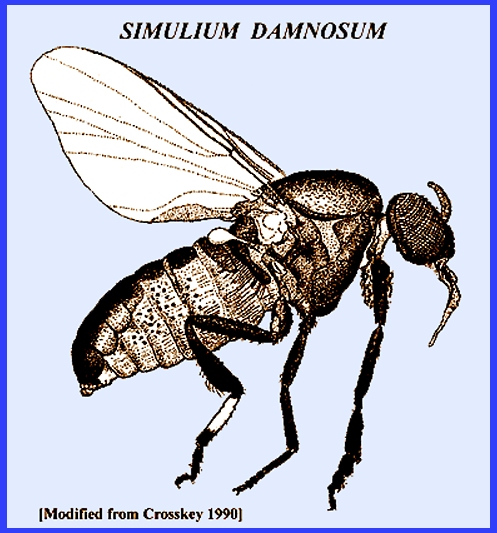File: <simuliidaemed.htm> <Medical
Index> <General Index> Site Description Glossary <Navigate to Home>
|
SIMULIIDAE (Blackflies) (Contact) Please
CLICK on Image
&underlined links to view: Also See: <Key To Simuliidae Genera> There are
four genera among over 2000 species that are of principal importance to
humans: Simulium, Prosimulium, Austrosimulium and Cnephia. However, Simulium is the most important as
many are vectors of disease. Service
(2008) reports that in Africa the main concern is with the Simulium damnosum
complex and the S. neavei
group. Central and South America have
Simulium ochraceum (S.
ochraceum is similar), S. metallicum
and S. exiguum complexes that
transmit parasitic nematodes that can cause onchocerciasis. In Brazil Simulium
amazonicum is a vector of Mansonella
ozzardi, which is a filarial parasite. The common
name for these flies varies, with "Black Flies" being used in some
countries or "Sand Flies" in others. In New York State blackflies are so pestiferous that a special
early summer festival is held in their honor. All species
are tiny and are recognized by a humped thorax. Further details of their morphology are given in Service
(2008). The dark
colored eggs are coated with a substance that allows them to adhere to rock
in flowing streams. Their habitats
are usually in rapidly moving streams but sometimes only slow moving water
can suffice. Female flies lay their
eggs over the water, but sometimes dive into it to oviposit. In cold areas the eggs may enter diapause. Larvae pass
through 6-11 instars, with the final instar being about eight times larger
than the adult. The larvae are
sedentary for a long time on submerged rocks and vegetation, adhering by a
secreted glue-like substance.
However, if disturbed they may dislodge and be carried downstream but
still attached to some substrate by a long silk-like thread. They eventually reattach to some object
downstream. When matue the larvae
make a cocoon into which they pupate.
The time they remain as pupae varies with temperature. Service (2008) noted that in Africa and
Asia blackflies show variable behaviors during their larval and pupal
development. Adults emerge and crawl
onto vegetation from where flight begins. Adult
blackflies feed on plant juices and other sugary substances, but only the
females take blood meals. Biting is outdoors
during daytime. Depending on the
species there is considerable variation in host preference and where they
prefer to bite on the body. Activity
is enhanced during cloudy, stormy weather.
Many species of blackfly feed preferably on birds while others show a
preference for mammals. The distance
that adult blackflies will range varies with the species and windy
weather. In colder climates biting
activity is seasonal, whereas in the tropics activity is all year with
heightened activity during rainy seasons. Service
(2008) reported that in Africa and Asia blackflies have a curious aquatic
association where East African larvae and pupae of S. neavei are not found on submerged rocks or vegetation
but on other aquatic arthropods like the nymphs of mayflies and some
crustaceans. MEDICAL IMPORTANCE OF BLACKFLIES Allergic
responses to the bites of blackflies can be very serious, but differ among
persons and animals. Side effects can
produce swollen lymph glands, aching joints, fevers and headaches. Onchocerciasis or
"River Blindness"
that is caused by the filarial parasite Onchocerca
volvulus is serious in some
parts of the world. A positive
attribute of blackflies is their use in medical research because of the very
large polytene chromosomes found in their salivary gland cells. Some studies have already shown that there
are 55 cytoforms in the Simulium damnosum
complex, which then facilitated the designation of distinct species. CONTROL Repellents
and clothing treated with pyrethrum compounds provide some protection against
blackflies. The application of
insecticides to breeding areas is widely practiced with World Health
Organization involvement, but resistance is a universal problem that makes
this approach ineffective after prolonged treatment. = = = = = = = = = = = = = = = = = = = = Key References: <medvet.ref.htm> <Hexapoda> Adler, P. H., D. C.
Currie & D. M. Wood. 2004. The Black Flies (Simuliidae) of North
America. Comstock Publ. NY &
London. Daley,
Beth. 2008. Black flies surge in
Maine's clean rivers. Boston Globe Boatin, B. A. & F.
O. Richards. 2006. Control of onchocerciasis. Adv. in Parasitol. 61: 349-54. Borradaile, L. A. &
F. A. Potts. 1958. The
Invertebrata: A Manual For The Use Of Students. Cambridge Univ. Press, Bentley Hs, London.
795 p. Crosskey, R. W. 1990.
The Natural History of Blackflies.
Wiley Publ., Chichester, England. De Villiers, P. C. 1987.
Simulium dermatitis in
man: clinical and biological features in South Africa. So. Afr. Med. J. 71: 523-25. Hough,
Andrew. 2010. Blandford
fly: surge in infected insect bites blamed on new superfly. The Daily
Telegraph. London. Matheson, R. 1950. Medical Entomology. Comstock Publ. Co, Inc. 610 p. Molyneux, D. H.
2005. Onchocerciasis control
and elimination: coming of age in resource-constrained
health systems. Trends in Parasitol.
21: 525-29. Service, M. W.
1977. Methods for sampling
adult Simuliidae, with special reference to the Simulium damnosum complex. Trop. Pest Bull. 5: 1- 48. Service, M. 2008.
Medical Entomology For Students.
Cambridge Univ. Press. 289 p
(See pp. 81-92). Legner, E. F. 1995. Biological control of Diptera of medical and veterinary
importance. J. Vector Ecology 20(1):
59-120. Legner, E. F.. 2000.
Biological control of aquatic Diptera. p. 847-870.
Contributions to a Manual of Palaearctic Diptera, Vol. 1, Science Herald, Budapest. 978 p. Thompson, F. C. 2001.
The Name of the Type Species of Simulium
(Diptera: Simuliidae): Ent. News
112(2): 125. |
= = = = = = = = = = =
= = = = = = = = =
FURTHER DETAIL = <Entomology>, <Insect Morphology>, <Identification Keys>
